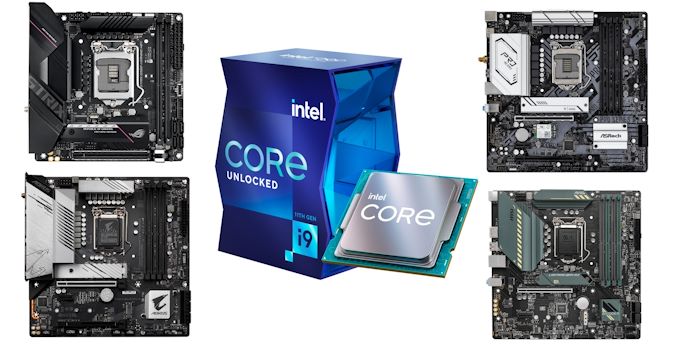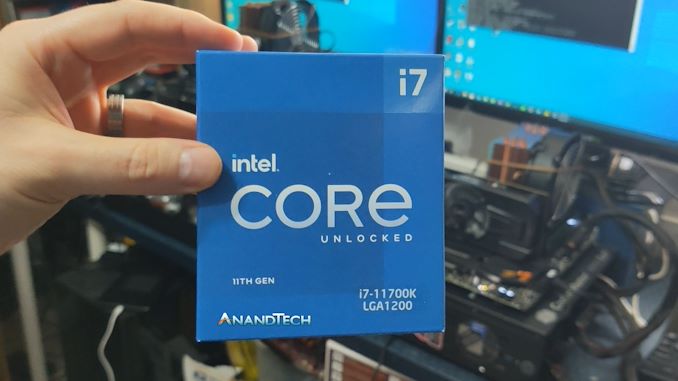Intel Rocket Lake (14nm) Review: Core i9-11900K, Core i7-11700K, and Core i5-11600K
by Dr. Ian Cutress on March 30, 2021 10:03 AM EST- Posted in
- CPUs
- Intel
- LGA1200
- 11th Gen
- Rocket Lake
- Z590
- B560
- Core i9-11900K
Conclusion
For anyone buying a new system today, the market is a little bleak. Anyone wanting a new GPU has to actively pay attention to stock levels, or drive to a local store for when a delivery arrives. The casual buyers then either look to pre-built systems (which are also flying off the shelves), or just hang on to what they have for another year.
But there is another way. I find that users fall in to two camps.
The first camp is the ‘upgrade everything at once’ attitude. These users sell their old systems and buy, mostly, all anew. Depending on budget and savings, this is probably a good/average system, and it means you get a good run of what’s available at that time. It’s a multi-year upgrade cycle where you might get something good for that generation, and hopefully everything is balanced.
The other camp is the ‘upgrade one piece at a time’. This means that if it’s time to upgrade a storage drive, or a memory kit, or a GPU, or a CPU, you get the best you can afford at that time. So you might end up with an older CPU but a top end GPU, good storage, good power supply, and then next time around, it’s all about CPU and motherboard upgrades. This attitude has the potential for more bottlenecks, but it means you often get the best of a generation, and each piece holds its resale value more.
In a time where we have limited GPUs available, I can very much see users going all out on the CPU/memory side of the equation, perhaps spending a bit extra on the CPU, while they wait for the graphics market to come back into play. After all, who really wants to pay $1300 for an RTX 3070 right now?
Performance and Analysis
In our Core i7-11700K review, our conclusions there are very much broadly applicable here. Intel’s Rocket Lake as a backported processor design has worked, but has critical issues with efficiency and peak power draw. Compared to the previous generation, clock-for-clock performance gains for math workloads are 16-22% or 6-18% for other workloads, however the loss of two cores really does restrict how much of a halo product it can be in light of what AMD is offering.
Rocket Lake makes good in offering PCIe 4.0, and enabling new features like Gear ratios for the memory controller, as well as pushing for more support for 2.5 gigabit Ethernet, however it becomes a tough sell. At the time we reviewed the Core i7-11700K, we didn’t know the pricing, and it was looking like AMD’s stock levels were pretty bad, subsequently making Intel the default choice. Since then, Intel's pricing hasn't turned out too bad for its performance compared to AMD (except for the Core i9), however AMD’s stock is a lot more bountiful.
For anyone looking at the financials for Intel, the new processor is 25% bigger than before, but not being sold for as big a margin as you might expect. In some discussions in the industry, it looks like retailers are getting roughly 20%/80% stock for Core i9 to Core i7, indicating that Intel is going to be very focused on that Core i7 market around $400-$450. In that space, AMD and Intel both have well-performing products, however AMD gets an overall small lead and is much more efficient.
However, with the GPU market being so terrible, users could jump an extra $100 and get 50% more AMD cores. When AMD is in stock, Intel’s Rocket Lake is more about the platform than the processor. If I said that that the Rocket Lake LGA1200 platform had no upgrade potential, for users buying in today, an obvious response might be that neither does AM4, and you’d be correct. However, for any user buying a Core i7-11700K on an LGA1200 today, compared to a Ryzen 7 5800X customer on AM4, the latter still has the opportunity to go to 16 cores if needed. Rocket Lake comes across with a lot of dead-ends in that regard, especially as the next generation is meant to be on a new socket, and with supposedly new memory.
Rocket Lake: Failed Experiment, or Good Attempt?
For Intel, Rocket Lake is a dual purpose design. On the one hand, it provides Intel with something to put into its desktop processor roadmap while the manufacturing side of the business is still getting sorted. On the other hand it gives Intel a good marker in the sand for what it means to backport a processor.
Rocket Lake, in the context of backporting, has been a ‘good attempt’ – good enough to at least launch into the market. It does offer performance gains in several key areas, and does bring AVX-512 to the consumer market, albeit at the expense of power. However in a lot of use cases that people are enabling today, which aren’t AVX-512 enabled, there’s more performance to be had with older processors, or the competition. Rocket Lake also gets you PCIe 4.0, however users might feel that is a small add-in when AMD has PCIe 4.0, lower power, and better general performance for the same price.
Intel’s future is going to be full of processor cores built for multiple process nodes. What makes Rocket Lake different is that when the core was designed for 10nm, it was solely designed for 10nm, and no thought was ever given to a 14nm version. The results in this review show that this sort of backporting doesn’t really work, not to the same level of die size, performance, and profit margin needed to move forward. It was a laudable experiment, but in the future, Intel will need to co-design with multiple process nodes in mind.












279 Comments
View All Comments
SystemsBuilder - Tuesday, March 30, 2021 - link
Honestly, I think they just mislabeled the 11900k and 11700k in the first 3D Particle Movement v2.1 tests result OR it's thermal throttling because they are exactly the same but architecturally (11900k higher frequencies).But the whole topic of AVX512 is interesting. It looks like Intel did not release Cypress Cove AVX-512 architecture details like they did for Sunny Cove last year (and Skylake-X cores before). But if Cypress Cove is close enough to Sunny Cove (and tit should be), they have crippled the AVX-512 quite severely but to confirm that we need to see the official Intel slides on core design. I am specifically talking about that core port 5 is crippled in Sunny Cove (compared to what Skylake-X and Cascade lake-X have) and does not include a FMA, essentially cutting the throughput in half for FP32 and FP64 workloads. Port 5 do have a ALU so Integer workloads should be running at 100% compared to Skylake-X. I really like to see Cypress Cove AVX-512 back end architecture design at the port level from Intel to understand this better though.
GeoffreyA - Tuesday, March 30, 2021 - link
I believe they added an FMA to Port 5, and combining that one and the FMA from Port 0, create a single AVX512 "port," or rather the high- and low-order bits are dispatched to 5 and 0.https://www.anandtech.com/show/14514/examining-int...
https://en.wikichip.org/w/images/thumb/2/2d/sunny_...
GeoffreyA - Tuesday, March 30, 2021 - link
I'm not fully sure but think Cypress is just Willow, which in turn was just Sunny, with changes to cache. Truly, the Coves are getting cryptic, and intentionally so.SystemsBuilder - Tuesday, March 30, 2021 - link
The official intel slide posted on this page: https://www.anandtech.com/show/14514/examining-int... (specifically this slide: https://images.anandtech.com/doci/14514/BackEnd.jp... , shows what i'm talking about. The 2nd FMA is missing on port 5 but the ALU is there - 50% of FP compute power vs. Skylake-X architecture. The other slide on wikichip is contradicting official intel slide OR it only applies to server side with full Sunny Cove enabled (usually the consumer client side version is a cut down).In any case these slides are not Cypress Cove so the question remains what have they done to AVX-512 architecture port 0+1 and port 5.
GeoffreyA - Tuesday, March 30, 2021 - link
You're right. I didn't actually look at the Intel slide but was basing it more on the Wikichip diagram and Ian's text. Will be interesting if we can find that information on Cypress C.JayNor - Tuesday, March 30, 2021 - link
"My main interest is getting the fastest single-core AVX available..."Rumors within the last week say there will be Emerald Rapids HEDT chips next yr. Not sure about Ice Lake Server workstation chips. If either of these provide dual avx512 they might be worth the wait.
SystemsBuilder - Tuesday, March 30, 2021 - link
I'm thinking Sapphire Rapids, which is due to arrive in late 2021 (very best case or, more likely, 2022), is the one to hold out for. Build on the better performing 10nm Finfet, it will add PCIe 5.0, DDR5 and further improve on AVX 512 with BF16 and AMX Advanced Matrix Extensions https://fuse.wikichip.org/news/3600/the-x86-advanc...Now, if you read about this you realize what step up for (FP and int) compute that is. Massive!
scan80269 - Tuesday, March 30, 2021 - link
It looks like Rocket Lake is the first desktop class x86 processor to support hardware acceleration for AV1 video format decode, similar to Tiger Lake for mobile. Interesting how this power hungry processor family can deliver good energy efficiency when it comes to watching 4K HDR movies/videos. OTT platform providers need to offer more content encoded in AV1, though.Hifihedgehog - Tuesday, March 30, 2021 - link
Meh... This is a fixed-function IP block for a very specific task so it is going to be low power. At this point, for most people, HEVC support is what actually matters. HEVC already offers a 50% improvement in bitrate efficiency over H.264, and AV1 only claims the same thing. Royalties or not, because HEVC was first to the game, it became the industry standard for UHD/4K Blu-ray. Timing is everything and AV1 missed the boat on that by about five years. So with the industry locked into HEVC, AV1 is going to have an incredibly hard time getting uptake outside of online streaming, which is a whole other ball of wax. And even then, as a content creator, you can use HEVC royalty free anyway if you are livestreaming on YouTube.GeoffreyA - Tuesday, March 30, 2021 - link
While AV1's quality is excellent, surpassing that of HEVC, its encoding speed is impractical for most people,* and I'm doubtful whether it's going to get much better. If people (and pirates, yes) can't use it easily, its spread will be limited. The only advantage it has, which I can vouch for anecdotally, is superior quality to HEVC. But even this advantage will be short lived, once VVC enters the fray in the form of x266. I've got no idea how x266 will perform, but from testing the Fraunhofer encoder, saw that VVC and AV1 are in the same class, VVC being slightly ahead, sharper, and faster.* libaom, the reference encoder. Intel's SVT-AV1 is faster but has terrible quality.